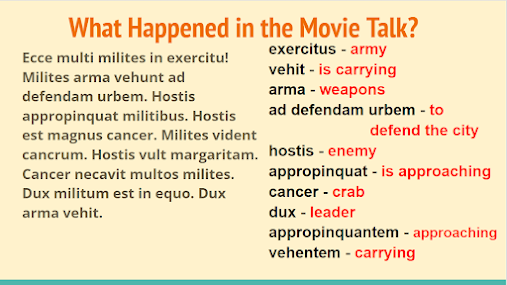This summer I attended IFLT (the first in-person IFLT since 2019), and I did not realize just how much I needed IFLT to "refill my cup"- I came away with a renewed spirit for the school year and so many new activities (specifically communicative-based) which I cannot wait to try out in my classes. I have already blogged about "communicatifying" existing activities, and now I want to add Write and Discuss - the OG version.
I attended a session called "Write and Discuss with Sprinkles" given by Caitlin McKinney, who addressed how to do a basic Write and Discuss and then gave many variations of it. In the session, we actually took part in the basic Write and Discuss and other variations in English as if we were students. Although I had already blogged about my experience with Write and Discuss, I did not have much knowledge or experience with the original way to do a Write and Discuss, and I learned that there are SO many different ways to do one (hence, the "sprinkles" which Caitlyn presented also). Therefore, I will call this blog post "Write and Discuss - the OG version" and call my previous blog post about the activity "Write and Discuss as PreWriting".
A Write and Discuss (OG version) is another way to review a reading/story, and it is done quite early in the scaffolding process of a reading. Following a story introduction (such as a movie talk, picture talk, TPRS story, etc), ask students to tell you corporately what happened in the story in the target language for the purpose of creating a class recap. You can ask students processing questions to guide students and to garner responses. As students give you responses, you will type out the sentence out on a projected document for the class so that they can see what you are writing (Caitlin used a Google Slide for this, and that works great, but I can also see using Google Docs or some type of document). As students recap what happened in the story and continue to contribute, you can also give students the option to add sentences of events or descriptions which happened prior in the story (filling in the gaps) or they can continue moving forward with the story. When you are finished, now you have a class-created document of the story which you can then review the next day with students as a warm up.
Last week, my colleague John Foulk and I did a Write and Discuss (OG version) for the first time. We did this activity with our Latin 3 classes immediately following a Movie Talk (Sand Castle) but because it was an upper level class, we added a new element. The movie talk itself took about 30 minutes, so immediately afterwards we projected the vocabulary from the movie talk and told students that they had five minutes to write in Latin what they could about the movie talk (which hopefully was fresh in their minds since we had just completed it). We then collected their writings and read over what they had written to get an idea of what students were communicating. Then the next day, we returned their writings and showed the movie short again (to rejog memories and for those students who were absent the day before). Following that, using a projected Google Slide, we began the Write and Discuss:
- Oh my gosh, I love this! What a great way to recap a story and have students do it for you, with you serving as their guide.
- I like that what I am dictating from students is being projected for students to see.
- I felt that this was another way for students both to interact with the passage in the target language and to receive more understandable repetitions of the language.
- Because this was a Latin 3 class, students were comfortable writing in the language prior to the Write and Discuss. NOTE - lower levels may not feel so comfortable doing a prewriting before the activity, so use your teacher discretion. Prewriting is not a requirement of a Write and Discuss. When Caitlin demonstrated a Write and Discuss in her presentation, I felt successful as a "student" with her just asking us questions aloud to elicit responses.
- It was John's idea for students do a writing of the story for five minutes immediately after the movie talk and prior to the Write and Discuss. When we did the Write and Discuss, students actually had something to which to refer when giving suggestions for the next sentence to add.
- I was surprised at how many students actually volunteered to provide a sentence. Again, maybe because they had already written something, this lowered their affective filters in offering a sentence instead of having to create/remember a sentence on the spot in Latin or answer me asking processing questions.
- Many students wanted to "fill in the gaps" with their own sentences between sentences which had already been provided - wow, I was impressed!
- I was surprised by how many students used vocabulary beyond what was provided for them or created their own sentences which were not originally from the Movie Talk.




No comments:
Post a Comment